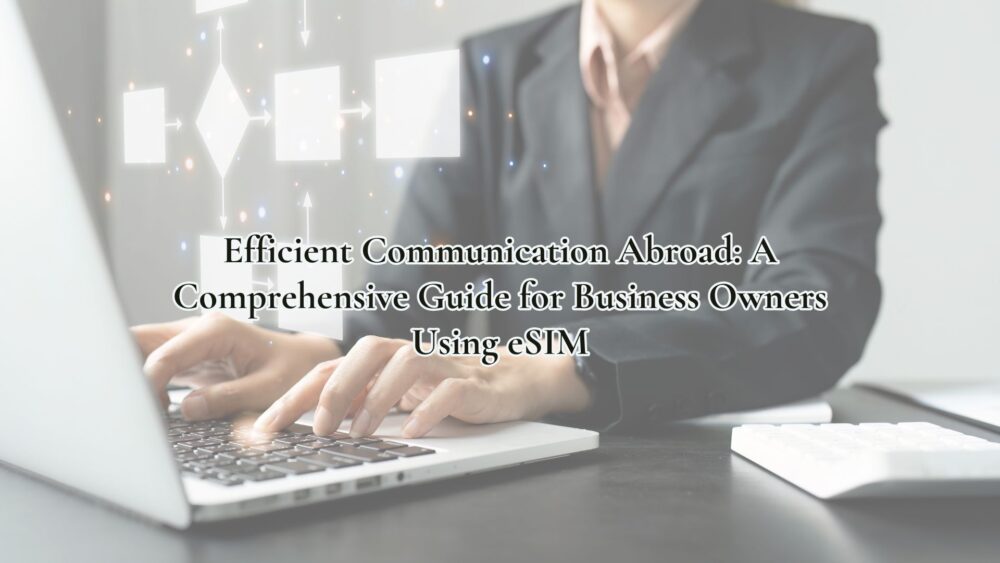Efficient Communication Abroad: A Comprehensive Guide for Business Owners Using eSIM helobaba.com


Communication while traveling internationally is essential. Yet, traditional connectivity methods like roaming charges or purchasing local SIM cards often need to be more convenient and affordable. This leaves professionals needing more subpar connections that disrupt operations abroad. Fortunately, with the emergence of eSIM technology, there is now a better way to stay efficiently connected across borders.
This guide helps global business owners use eSIMs effectively. Learn benefits, implementation steps, best practices, and future innovations. Maximize travel productivity and cut connectivity issues. Discover how eSIMs can transform your business communications worldwide.
Understanding eSIM Technology
An eSIM, or Embedded Subscriber Identity Module, is a digital SIM card embedded within a device. Unlike physical SIM cards, eSIMs allow you to remotely switch cellular plans and networks without having to physically change SIM cards. By downloading provider profiles over the air, you can activate optimal local carrier plans in different countries instantly.
eSIMs are embedded in many modern smartphones and devices either as the sole SIM card method or alongside a single physical SIM slot. This enables the most flexibility in managing connections. For globetrotting business owners, eSIMs unlock game-changing convenience and cost optimization opportunities.
What are the Main Benefits of Using eSIM for International Travel?
The main benefits of using eSIM for international travel include:
- Flexibility and Convenience: Easily switch between different carrier profiles without physically changing SIM cards.
- Cost-Effectiveness: Avoid roaming charges by choosing local data plans in your destination country.
- Space-saving: Since eSIMs are embedded, they don’t take up physical space, allowing for slimmer device designs.
- Multiple Accounts Management: Store and manage several profiles for different destinations, making it ideal for frequent travelers.
Efficient Communication Practices with eSIM
Optimizing your eSIM usage requires more than just technical configuration – you must leverage eSIM capabilities for efficient communication practices. Take advantage of features like dual SIM mode to reduce switching profiles constantly. For resources and guidance on eSIM management, consider exploring Holafly.
Identify carriers with affordable roaming packages as a backup for areas with limited local plan options.
Monitor data consumption closely to avoid overages. Disable previous profiles when activating new plans to prevent billing conflicts.
Set usage alerts to control costs. Use eSIM connectivity features like call forwarding strategically while traveling and transitioning networks. Follow these tips to maximize the value of your eSIM for effective business communication.
Planning Your Communication Strategy Abroad
Planning your communication strategy before international travel is crucial. Evaluate your itinerary, and business needs, and choose suitable eSIM solutions. Think about the countries you’re visiting, data and voice requirements, and trip duration. Research which local carrier plans provide the best coverage and rates in each area.
With this information, you can determine the right mix of eSIM profiles to download for each location. For example, if traveling across Europe, you may activate a local carrier plan in each country to avoid roaming charges. In contrast, a single regionally optimized plan may suffice if visiting multiple cities within one country.
Align your eSIM plan selection to your trip timeline and objectives in each area. Advanced preparation is key. Configure profiles before departure, not upon arrival. Benefit from eSIM features for seamless network switching between countries. Focus on business, not connectivity, with the right eSIM setup.
What to do if You Encounter Connectivity Issues Abroad?
If you encounter connectivity issues abroad, try the following steps:
- Restart Your Device: Sometimes, a simple restart can resolve connectivity issues.
- Check Carrier Compatibility: Ensure that the eSIM profile you’re using is compatible with the local network.
- Manage eSIM Profiles: If switching profiles, ensure the correct one is activated and properly configured.
- Seek Support: Contact your eSIM provider for assistance or to verify if there’s a network outage affecting service.
- Local Wi-Fi: As a temporary solution, connect to local Wi-Fi networks where possible.
Overcoming Communication Barriers
Navigating language and cultural nuances poses significant communication challenges abroad, potentially impacting business dealings. eSIMs can help overcome these barriers through features like real-time translation services while roaming internationally. Activating region-specific plans also provides access to local customer support.
Research business etiquette, greeting customs, communication norms, and taboos in your destination beforehand. Download translator apps and offline language packs to bridge language gaps. Use your eSIM’s robust connectivity to research local information to avoid miscommunication. With preparation and the right tools, an eSIM helps you successfully navigate communication abroad.
Implementing eSIM for Business Travel
Adopting eSIM for seamless global business connectivity involves thoughtful implementation. Confirm your device has an integrated eSIM or supports an eSIM card. Research plan options from leading carriers in your destinations. Use online account portals to activate and manage profiles, downloading multiple in advance if required.
Test switching between profiles and verify service before departure. Set up autopay accounts with international capabilities to manage monthly plans easily. Troubleshoot issues through carrier customer support and forums. With careful setup, eSIM can provide a smooth, connected experience in even the most remote corners of the globe.
Future of International Business Communication
Looking ahead, eSIM innovation will continue transforming business communication abroad. More carriers will support eSIM activation, expanding plan options globally. Integration into wearables and tablets will increase eSIM accessibility. Automation will simplify profile activation and switching, optimizing connectivity.
eSIMs coupled with high-speed 5G networks will enable new communication capabilities for global enterprises. eSIM tech enables constant, cheap data and voice access. It’s ideal for businesses worldwide. Future international business thrives on mobility and connectivity. eSIM drives this trend.
Conclusion
Global business travel is rising, and professionals need strong mobile communication. Staying connected abroad was tough, but eSIM tech simplifies it. eSIMs offer easy network switching and localized connectivity for owners. It’s a game changer for affordable, reliable global communication.
This guide simplifies eSIM features, activation, usage, and future potential. It helps professionals adopt eSIM-enabled mobility. Prepare well and strategize for seamless global expansion: ditch roaming fees and connectivity issues with eSIM for borderless business.
FAQs
1. How does eSIM technology benefit business travelers?
eSIM technology offers business travelers the convenience of switching between carriers without needing physical SIM cards, ensuring constant connectivity and cost-efficient plans across different countries.
2. Is worldwide coverage guaranteed with an eSIM?
While eSIMs offer broad international coverage, it’s dependent on partnerships between your eSIM provider and local networks. Always verify coverage for your destination before travel.
3. What strategies can I employ to minimize data costs abroad?
To minimize data costs:
- Use data tracking tools to monitor usage.
- Opt for eSIM plans with favorable international rates.
- Utilize Wi-Fi for heavy data activities.
- Select plans with transparent overage policies.
4. How should I choose an eSIM provider for international business travel?
Choosing an eSIM provider:
- Assess coverage in your destinations.
- Compare plan flexibility, costs, and data packages.
- Read feedback from other travelers on service reliability.
- Ensure customer support is accessible and helpful.









